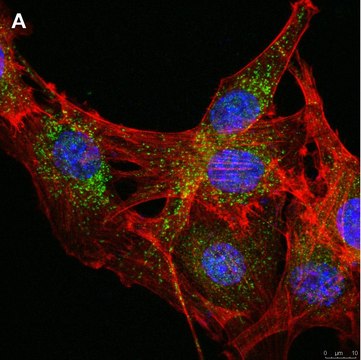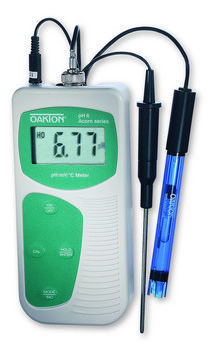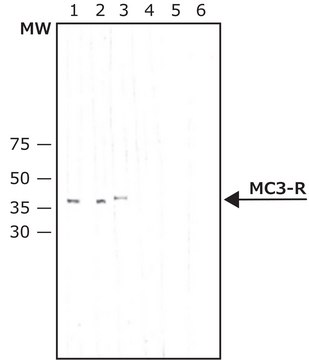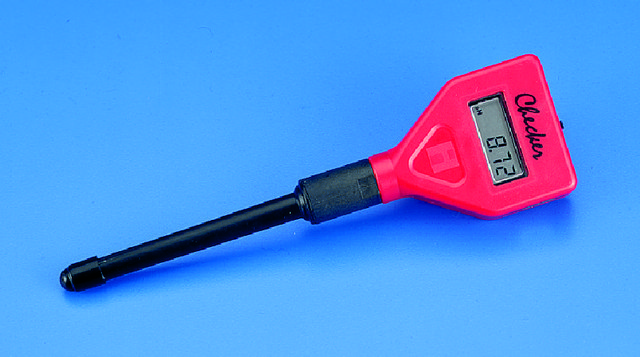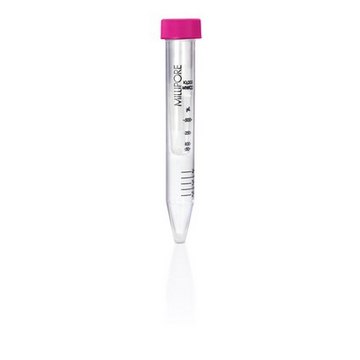H9911
Anti-Hepatocyte Growth Factor Receptor antibody produced in goat
lyophilized powder, affinity isolated antibody
Synonym(s):
Anti-HGF Receptor
Sign Into View Organizational & Contract Pricing
All Photos(1)
About This Item
Recommended Products
biological source
goat
Quality Level
conjugate
unconjugated
antibody form
affinity isolated antibody
antibody product type
primary antibodies
clone
polyclonal
form
lyophilized powder
species reactivity
mouse
technique(s)
immunohistochemistry: 5-15 μg/mL using using cells and tissue
western blot: 0.1-0.2 μg/mL
UniProt accession no.
storage temp.
−20°C
target post-translational modification
unmodified
Gene Information
mouse ... Met(17295)
Related Categories
General description
Blockade of receptor-ligand interaction: In a functional ELISA, 0.3-1 μg/mL of this antibody will block 50% of the binding of 5 ng/mL of Recombinant Human HGF to immobilized Recombinant Mouse HGF R/cMET Fc Chimera coated at 1 μg/mL (100 μL/well). At 20 μg/mL, this antibody will block >90% of the binding.
Immunogen
purified recombinant mouse hepatocyte growth factor receptor extracellular domain expressed in insect Sf 21 cells.
Biochem/physiol Actions
Hepatocyte Growth Factor (HGF) is a multifunctional, heparin-binding factor that stimulates the proliferation of liver cells. The cellular effects of HGF are mediated by its receptor, c-Met, that leads to significant activation of ERK, Src/FAK, STAT3 and PI3K signaling. Various functions of the HGF/c-Met signaling include proliferation, cell survival, motility, adhesion and tissue regeneration. Apart from liver, HGF also mediates regeneration of kidney, lung and gastro-intestines.
Physical form
Lyophilized from a 0.2 μm filtered solution in phosphate buffered saline (pH 7.4) with 5% trehalose.
Disclaimer
Unless otherwise stated in our catalog or other company documentation accompanying the product(s), our products are intended for research use only and are not to be used for any other purpose, which includes but is not limited to, unauthorized commercial uses, in vitro diagnostic uses, ex vivo or in vivo therapeutic uses or any type of consumption or application to humans or animals.
Not finding the right product?
Try our Product Selector Tool.
Storage Class Code
11 - Combustible Solids
WGK
WGK 1
Flash Point(F)
Not applicable
Flash Point(C)
Not applicable
Personal Protective Equipment
dust mask type N95 (US), Eyeshields, Gloves
Regulatory Information
新产品
Choose from one of the most recent versions:
Already Own This Product?
Find documentation for the products that you have recently purchased in the Document Library.
K Matsumoto et al.
Critical reviews in oncogenesis, 3(1-2), 27-54 (1992-01-01)
Hepatocyte growth factor (HGF) is the most potent mitogen for mature hepatocytes and seems to act as a hepatotropic factor that has not been purified over the past 30 years. HGF was first purified from rat platelets in 1986. HGF
Shinya Mizuno et al.
Frontiers in bioscience : a journal and virtual library, 13, 7072-7086 (2008-05-30)
Hepatocyte growth factor (HGF) and Met/HGF receptor play roles in dynamic growth and morphogenesis during development and regeneration of organs, including the kidney. In the kidney, HGF targets different types of cells, while its biological actions depend on a target
Rie Nakahira et al.
Biochemical and biophysical research communications, 341(4), 897-903 (2006-02-16)
The stomach is constantly exposed to mechanical and chemical stresses. Under persistent damages, epithelial cell proliferation is required to maintain mucosal integrity. Nevertheless, which ligand system(s) is physiologically involved in gastric defense remains unclear. Herein, we provide evidence that HGF
H Ohmichi et al.
The American journal of physiology, 270(6 Pt 1), L1031-L1039 (1996-06-01)
Hepatocyte growth factor (HGF) has mitogenic, morphogenic, and motogenic activities on epithelial cells and plays important roles in regeneration of the liver and the kidney. We previously found that the expression of HGF gene is rapidly induced in the lung
Toshikazu Nakamura et al.
Proceedings of the Japan Academy. Series B, Physical and biological sciences, 86(6), 588-610 (2010-06-17)
It has been more than 25 years since HGF was discovered as a mitogen of hepatocytes. HGF is produced by stromal cells, and stimulates epithelial cell proliferation, motility, morphogenesis and angiogenesis in various organs via tyrosine phosphorylation of its receptor
Our team of scientists has experience in all areas of research including Life Science, Material Science, Chemical Synthesis, Chromatography, Analytical and many others.
Contact Technical Service

